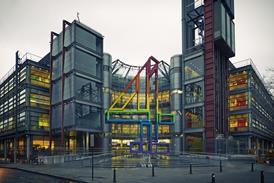Sony: solid state EX adopted by indies
Despite Sony pushing its disc-based recording system, XDCAM HD, as a workhorse for broadcast, few producers have so far adopted it for broadcast. Broadcasters such as Sky and the BBC decided not to accept its output, recorded from half-inch CCDs, as suitable for HD production.
However the launch of the high-spec PDW-700 model last spring changes that. Sporting a 2/3 inch chipset to record full 1920x1080 4:2:2, footage is not only certified for use by major broadcasters but, at less than the cost of a new Digital Betacam, the model has been purchased by most of the main rental houses.
Says Dennis Lennie, business development manager for reseller CVP-Mitcorp: “With Sony XDCAM 422, Sony can be confident it finally has the technology to woo previously undecided producers away from tape into HD and IT workflows.”
It also seems Sony can't ship its new solid-state camcorders EX1 and EX3 fast enough. Sony product manager Phil Meyers reports: “We've far exceeded our sales expectations. The EX1 is finding a home in documentary work where shoot ratios are 10 or 20 to 1 and where producers want rapid ingest to a laptop or output as a file.”
Tiger Aspect, RDF, Mentorn and Lion TV are among the indies which have adopted the EX1 and its 1920x1080 HD output has been approved for use by National Geographic. Special Treats Productions has shot behind the scenes material for Quantum of Solace on the EX1 while Raw Cut's Sky One documentary Road Wars is also shot on the format.
The EX1, which costs around£4,000, is an HD-only solution so users have no choice but to shoot HD and on solid state. The EX3 is a slightly larger version offering interchangeable lenses.
Sony has also replaced the HDV camcorder Z1 which has proved a staple of location recces, budget documentaries and second camera point of view shots on larger productions. The new HVR-Z5E features a superior CMOS image sensor to the Z1 but the main advance is that it offers a choice of capturing HDV (DV or DVCAM) onto tape, memory card or hard disk drive. Says Sony Europe senior product manager Bill Drummond: “The Z1E has been a fantastic success but technology has moved on. With the Z5, users can record DV onto memory card and HDV onto tape at the same time if they wish.”
Panasonic: P2 targets mainstream
Panasonic's P2 technology has found favour among news broadcasters and its next target is mainstream broadcast programming. Sky News has outfitted with the AJ-HPX2100 shoulder-mounted camcorder, making it one of Panasonic's biggest customers, while Bloomberg and Reuters have also chosen P2 for acquisition.
“Across Europe the take-up of P2 is dominant,” claims Panasonic European marketing manager Marc Irwin. “80% of broadcasters that have IT infrastructure have got P2. Now we're looking to introduce P2 into drama, docs and daytime programming.”
All the firm's high end cameras from the HVX200 upwards now record to P2 cards which come in capacities of 16GB, 32GB and 64GB. Indeed it has stopped developing new tape-based cameras, although it will still support current tape product in future. Perhaps the main drawback to P2 remains the price of the media - a 64GB card costs around£800. Nonetheless five of them (fitting the five card slots in the high end cameras) will hold a good five to six hours of HD material.
“A number of rental companies have begun offering cards for hire,” says Irwin. “If you bought 10 hours of HDCAM or even HDV tape you could rent the same capacity of P2 cards for less.” To rent a single P2 card for a day costs around£15 to£20 he says while individual tapes cost from£30. He observes that the reticence among camera operators and producers in terms of trusting file-based workflows is hampering the adoption of tapeless formats.
“It's odd because previously they would stick tapes in a Jiffy bag and send them by post or courier and be more confident they would arrive than if they had sent them as files.” The ace up Panasonic's sleeve is a compression scheme, based on the H.264 MPEG-4 standard, which is said to be very efficient.
AVC-Intra (where AVC stands for Advanced Video Coding and Intra is for intraframe) is accessed from the menu-systems of P2 cameras and can be set at 100Mbps for 1920 x 1080 10-bit 4:2:2 recording or 50 Mbps 1440 x 1080 10-bit 4:2:0 recording for DVCPRO HD quality at half the bandwidth - reducing file sizes and doubling the record time on a P2 card.
Ikegami: launches GF Series capable of producing in HD and SD
Ikegami, which pioneered tapeless camcorders with the introduction of the Editcam in 1995, has launched a Flash-based HD/SD camcorder. The GFCAM tapeless camcorder (HS-V10) records full HD 1920x1080 resolution in MPEG-2 compression and MXF file formats to new solid-state removable media, GFPAK. This is a proprietary format using Flash memory developed by Toshiba, which is an investor in Ikegami.
The GFPAKs will initially come in 16GB, 32GB and 64GB flavours with a single 32GB GFPAK costing about£450 - rather expensive compared with CompactFlash cards. However, the format has a big advantage over CompactFlash in that it uses a Serial ATA interface used by many fast hard drives, giving it a throughput of 1.5Gbps - considerably faster than rival systems. The GFPAK also has a mini USB 2.0 connector for direct connection to an NLE.
The GFCAM system also includes the GFStation recording deck and a portable version - the GFStation Portable which also record to GEPAK. Video can also be transferred to a 300GB external holographic disk drive. Holographic storage is an emerging technology which promises large strides in increasing capacity and speed on DVD-sized discs.
According to Mark Capstick, general manager, Ikegami Electronics UK: “The whole GFSeries is capable of production in both HD and SD, making it a future-proof choice for any production company working in new to high-end productions. The whole system is 50/60Hz switchable, so there is one product range for production worldwide.”
Ikegami has also had success with its HD studio camera the HDK-79EXIII. ITV Productions invested£500,000 on eight models including lenses for the HD production of Emmerdale during the summer.
Ikegami still manufactures the Editcam system, which uses Avid file formats, with separate HD and SD cameras. These can operate with either hard disk or solid state recording media (FieldPaks or RAMPaks), and integrate well with Avid NLEs. The Editcam HD (HDN-X10) records at 145Mbps with Avid's DNxHD codec for very high quality video productions.
JVC: joining the tapeless club with GY-HD250
JVC has become the latest camera manufacturer to join the tapeless club by announcing support for Sony's XDCAM EX MPEG-2 file format and SxS flash memory media. From March 2009 it will ship a media recorder costing under£2,000, the KA-MR100G, as its first product featuring native XDCAM EX file recording and an SxS memory card slot. The recorder can be sandwiched between the battery plate and the camera body of current JVC ProHD GY-HD200/250 series camcorders via an adapter. It permits recording of HDV to tape or solid-state.
“Users will be able to shoot material on our camcorders or on XDCAM EX and know that recording from both will be compatible,” explains JVC Europe product manager Semir Nouri. “That means customers don't have to invest in new NLE technology if they have a system that supports EX files.”
By all accounts the move was a pleasant surprise for Sony and somewhat uncomfortable for Panasonic. Panasonic (formerly Matsushita) only recently divested its shareholding in JVC. “The alternative solid-state option, Panasonic's P2, uses the PCMCIA format which is no longer being supported as standard by the vast majority of PC manufacturers,” Nouri adds. “Most users will want to work in the most direct and future-proofed way with footage and that is through the PCI Express interface which laptop manufacturers support.” Panasonic's Irwin responds: “It's not a case of manufacturers not supporting P2 because P2 is a workflow not a card. Indeed all manufacturers of leading NLEs support P2. Just because some people have pulled away from PCMCIA means nothing. We have an inexpensive adaptor which slots into any PC and doesn't slow work down.”
JVC is also producing a camcorder which records to Compact Flash SDHC. A 16GB card costs under£30 and can record an hour of HDV. A 32GB card will soon be available.However, Nouri says they have not abandoned tape.
It also has a new media recorder (MR-HD100), developed by Focus Enhancements, which lets producers manage metadata wirelessly while shooting is in progress.
“You could use a mobile phone, log into the media recorder remotely via a web browser, add metadata information and assign it to the video while recording,” explains Nouri. “If you're shooting a soccer match for example you could add metadata tags for events like a goal ahead of time and these are automatically applied during acquisition.”
Thomson Grass Valley: integrates with Avid and Apple NLEs
Until recently, mention of Thomson's tapeless camera Infinity was typically prefixed with the words “long overdue”. First introduced as a concept in September 2005, the Infinity has since been on a development journey, with its full release delayed to accommodate new CMOS sensor technology. It's now been on the market for a year but despite sales to small news organisations, medium-sized broadcasters and freelancers, it has made few inroads into broadcast production.
That could change with the introduction of two new features. For an extra£3,000 (on top of the£17,000 per camera) users can add 24p capture capability which will make it attractive to those seeking a filmic look. It currently operates at 720p 50/60 and 1080i 50/60.
Thomson Grass Valley has also addressed arguably its main weakness which was a lack of integration with the non-linear editing systems from Avid and Apple. A new MPEG codec means the camera will generate files compatible with Media Composer and Final Cut Pro.
“Those particular editing systems have had their workflow developed in line with Sony's MPEG-based camcorders. We have followed suit,” explains Klaus Weber, director of product marketing cameras.
Benefits of the Infinity include the ability to record to Rev Pro solid state media (a physical cartridge that can be handled in the same way as tape), simultaneously to CompactFlash cards, allowing content to be downloaded at faster than real-time speeds into editing systems.
Also new for the firm's flagship range of studio and OB cameras (LDK 4000 and 8000 Elite) is an image-processing capability which delivers gains in picture quality (or light sensitivity) equivalent to one f-stop.
A new chipset contains additional features for “digital cosmetics” - sometimes known as negative skin contours - and secondary colour correction for manipulating images inside the camera.
Existing Elite cameras can be upgraded for around£4,800.

























No comments yet